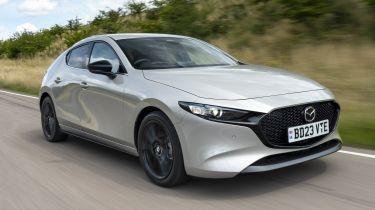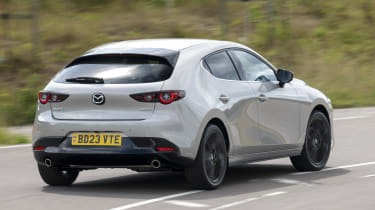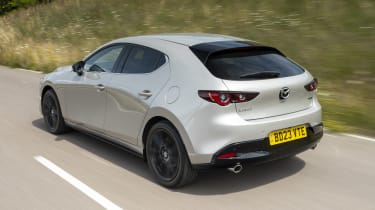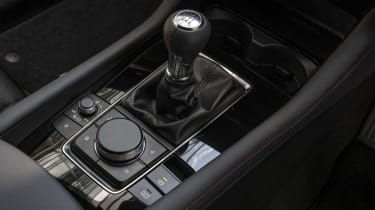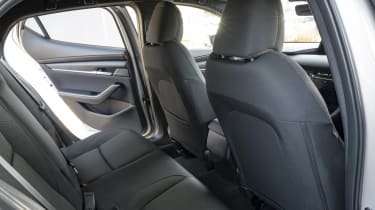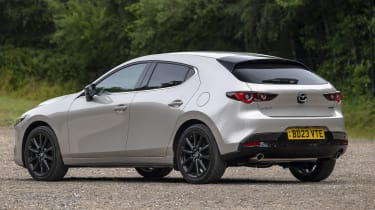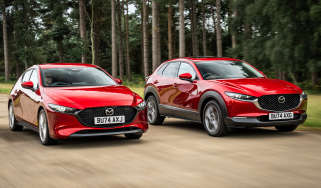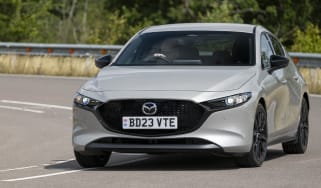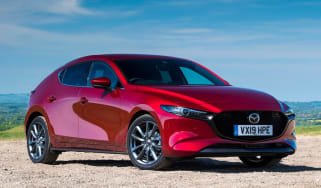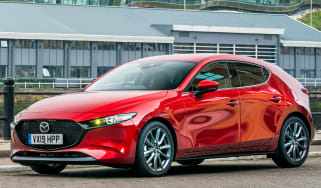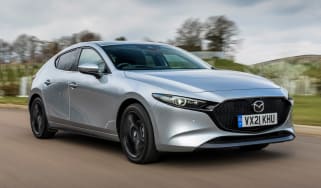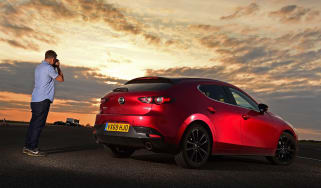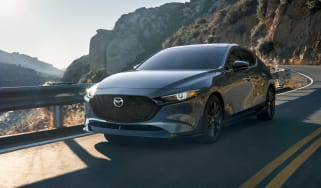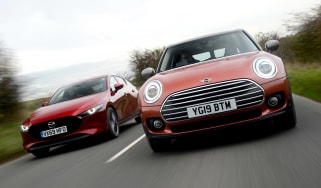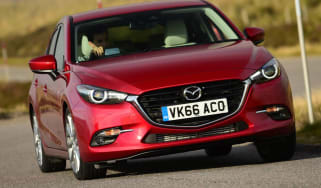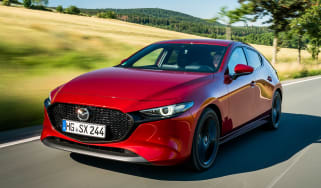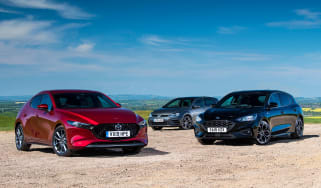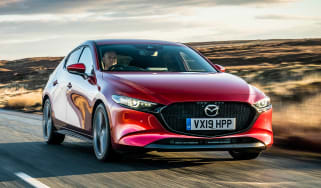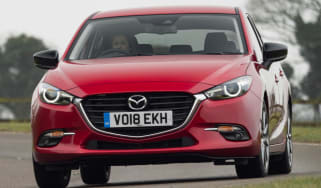Mazda 3 review: a stylish and sensible hatchback that’s also great to drive
The Mazda 3 looks fantastic, drives brilliantly and rides well, but some rivals are more practical all-rounders

The Mazda 3 is still a great family hatchback and among the more desirable-looking models you can currently buy. It's fun to drive, extremely well-equipped, and offers a package of immense quality for the money. Granted, it’s not the most practical option out there, whether you choose the hatchback or the saloon alternative.
The more powerful SkyActiv X petrol engine employs groundbreaking technology, but you’ll struggle to detect it at work. Other rivals offer more efficient plug-in hybrid systems, which will be more appealing – particularly to business users. However, if you can live with the minor downsides, the Mazda 3 remains a rewarding and exciting family car to live with.
About the Mazda 3
The Mazda 3 is a car aimed squarely at family buyers who enjoy driving – whether they settle on the handy hatchback or sleek saloon version. The Japanese manufacturer has pitched this fourth generation Mazda 3 upmarket with the intention of toppling premium rivals in the class. No mean feat.
To that end, the latest generation Mazda 3 can be considered a total revolution over its predecessor. It employs a smoother, sportier design language, a significantly repackaged interior, up-to-the-minute driver assistance features, and a new platform. Like Mazda icons of the past, unconventional engine technology plays a crucial role in setting the new Mazda 3 apart from the crowd.
Used - available now
Alongside the Golf we mentioned above, key rivals for Mazda’s newcomer include the Ford Focus and Honda Civic – also cars majoring in sporty driving dynamics – alongside bona fide premium players like the Audi A3, BMW 1 Series, and Mercedes A-Class. All hatchback versions are five-door cars, while a four-door saloon version of the Mazda 3 is also available.
The Mazda 3 trim line-up has been updated as of 2023 and completely renamed, although there are still five levels to choose from and not all are available with both engine variants. Prime-Line is the well-equipped entry-level model that comes exclusively with the 120bhp 2.0-litre SkyActiv G petrol engine. That’s followed by our preferred trim level, Centre-Line, which can be ordered with both the SkyActiv G, and the 183bhp 2.0-litre SkyActiv X, as can Homura, Exclusive-Line, and top-of-the-range Takumi. The entry-level SkyActiv G is fine for those who mostly drive in town, but we recommend you go for the more powerful SkyActiv X because it has much better performance out of town, and is actually the most efficient engine in the range.
On top of the trim level changes, the engine line-up has been altered since the current Mazda 3 arrived in 2019. The only diesel (a 114bhp 1.8-litre SkyActiv D) has been discontinued due to falling demand, as has the option of four-wheel drive.
The engine range is made up of two petrol engines, as mentioned above. Both feature a six-speed manual gearbox as standard, with the option for a six-speed automatic. All cars are front-wheel drive, with both engines using 24v mild-hybrid technology to boost overall efficiency further, but only the least powerful petrol can deactivate two of its four cylinders when cruising under light accelerator applications to save fuel.
Engines, performance and drive
Mazda has carved a reputation for delivering family cars with a thrilling edge, and while the Mazda 3 lacks a true performance variant, we think it lives up to this reputation for fine handling. It feels solid and confidence-inspiring from behind the wheel.
That’s apparent the moment you take a seat inside. While there’s little in the way of feedback from the steering (few mainstream cars supply this these days), at least the Mazda 3’s steering rack is weighted well. The speed of the electric power steering motor is spot on, too, resisting the urge to re-centre too quickly like on a Ford Focus, but being sharper than a Skoda Octavia or VW Golf in this regard.
The six-speed manual gearbox is simply the best in class and an absolute joy to use. The throw is short, while the action is tactile and mechanical in its feel. The six-speed automatic isn’t quite as strong as other auto options because Mazda still uses a torque converter rather than to the faster-shifting dual-clutch transmissions that have become popular in the segment. Even with wheel-mounted paddles (provided on Exclusive-Line trim cars and above), this gearbox doesn’t respond quickly enough for our liking.
The Mazda 3 is responsive on turn-in, and by family car standards, it’s extremely composed. A lot of that can be put down to standard G-Vectoring technology, which monitors various parameters and works preemptively to reduce engine power just enough so the front wheels aren’t overwhelmed during hard cornering and, therefore, allow the tyres to maintain their grip on the road. There is a little body roll, but it rolls in a very progressive manner, so you’ll quickly learn to adapt your driving style to suit.
Perhaps more impressive is how the Mazda 3 manages to be fun to drive while retaining excellent ride quality. The firm’s engineers have struck a sweet spot between forgiving springing and damping and body control, and while a Golf is still the most comfortable family hatchback on sale, the Mazda manages its priorities better than an ST-Line or ST-Line X equipped Ford Focus with stiffer suspension, by being just as fun from behind the wheel while riding better in the process.
0-62mph acceleration and top speed
In contrast to its many rivals, the Mazda 3 forgoes any turbocharged engine options. Instead, you have a large capacity (for a modern family hatchback) 2.0-litre engine, which in both 120bhp SkyActiv G and 183bhp SkyActiv X forms comes with 24v mild hybrid assistance.
The basic 2.0-litre four-cylinder SkyActiv G petrol option is naturally aspirated, while the new SkyActiv-X petrol uses a supercharger – although it isn’t there for any kind of power boost (we were disappointed to find that out, too). It’s an essential element of this engine's spark-controlled compression ignition (SCCI) technology. It is really only there to control the flow of air into the engine and can quickly feed in more air, if required, to improve efficiency.
Starting with the basic 2.0-litre four-cylinder SkyActiv G engine, power stands at 120bhp with peak torque of 213Nm delivered at 4,000rpm. Mazda claims 10.4 seconds from 0-62mph for manual cars, with automatic versions taking 10.8 seconds. Top speed stands at 122mph.
Figures like these won’t trouble any of the torquier alternatives on the market, but in practice, we’ve found the SkyActiv G adds up to be a little more than the sum of its parts. During our group test against more powerful, turbo versions of the Golf (1.5 TSI 130) and Focus (1.0 EcoBoost 125), we clocked faster 0-60mph times than the official numbers suggest, with the off-the-line pace boosted by the Mazda’s mild-hybrid system.
However, in-gear acceleration times exposed the relatively small amount of torque on offer, which would hamper any overtaking attempts when passing slower traffic on a country road. It is refined, though, remaining hushed right through the rev band. In sixth at motorway speed, it’s quiet, pairing off nicely with the low wind noise levels.
The SkyActiv-X petrol is the engine to go for, developing 183bhp and 240Nm of torque. The extra power means it can get from 0-62mph in 8.1 seconds (8.5 seconds for the automatic) and hit a top speed of 134mph – where it’s legal to do so.
Start the car, and it idles like a petrol, but as the engine reaches mid-revs, it begins to mimic the sound of a diesel. Push through towards the 6,500rpm redline, and the noise returns to that of a conventional petrol engine. It’s not quite as refined as the SkyActiv G engine, but it’s a much better performer for everyday motoring. It’s also great to finally have a little more pep to exploit the excellent chassis, too, making the SkyActiv X our pick of the line-up.
MPG, CO2 and running costs
We recorded a figure of 41.4mpg over 464 miles in a manual Mazda 3 with the SkyActiv G engine, which was close to the 45.6-44.8mpg manufacturer figures at launch. Improvements made since then with mild-hybrid technology and cylinder deactivation mean this engine is now capable of 53.3mpg on the WLTP combined cycle.
CO2 emissions of 124g/km for the manual version and 134g/km for the automatic variant aren't particularly remarkable numbers when you consider the low emissions of hybrid rivals such as the Honda Civic and Toyota Corolla, let alone the quoted figures of PHEV rivals like the Peugeot 308 and Vauxhall Astra. Any company car drivers paying Benefit-in-Kind (BIK) tax won't find huge appeal in the 29 to 31 per cent ratings.
The SkyActiv X petrol engine is the best combination of efficiency and performance, with Mazda claiming up to 56.5mpg for the manual car we’d recommend. In our 2023 group test we managed 42.5mpg (on a combination of A and B roads and motorway driving) in a SkyActiv X GT Sport model with automatic transmission. Mazda claims the average economy should be around 47.9mpg - so not too far away in real world driving.
Insurance groups
The Mazda 3 SkyActiv G models occupy insurance groups 16 and 17, depending upon whether you have the entry-level Prime-Line or range-topping Takumi. Rivals like the Vauxhall Astra also start in group 16, but if you want something cheaper to insure, then the Kia Ceed starts in group 14.
The more powerful SkyActiv X understandably sits in a higher insurance range of 22-23, which is less than plug-in hybrid rivals and the similarly powerful Honda Civic.
Depreciation
Our experts predict that the Mazda 3 will retain around 48 to 49 per cent of its value after three years and 36,000 miles, which is broadly in line with rivals like the Cupra Leon, and Vauxhall Astra but slightly behind the more premium Audi A3 - retaining an average of 55 per cent after three years of ownership.
To get an accurate valuation on a specific model check out our free car valuation tool...
Interior, design and technology
The Mazda 3 is one of the best-looking family cars on sale; its aggressively sporty styling isn’t too far removed from the Kai concept car that first appeared at the 2017 Toyko Motor Show. As with other modern Mazda products like the CX-5 and MX-5, the 3 has been designed to look fast and powerful even at a standstill – the result is a family car that looks far sportier than its competition. It’s a handsome car that looks decidedly up-market.
The Mazda 3 also sets itself apart by feeling more driver-focused than its rivals, with great ergonomics and a fantastic driving position built around the driver’s needs. That’s apparent the moment you take a seat because of the low seating position, as well as the armrests on the centre console and driver’s door card that are perfectly positioned for your elbows. The wheel is well-sized, and the rim isn't too thick, making it ideal for exploiting the Mazda 3’s tidy handling.
The Mazda 3 has a classy feel inside, with simple lines and a deliberate lack of buttons. The dashboard has a wrap-around feel and is topped with an infotainment screen that’s controlled by a rotary dial behind the gear lever. Simple heater controls are provided by easy-to-use buttons rather than being relegated to awkward-to-use touch-sensitive sliders like the VW Golf, or buried within the touchscreen, as in most Ford Focus trim levels. The Mazda 3 doesn’t have a fully digital driver instrument cluster, and while it lacks the configurability of a digital display, it is refreshingly simple and easy to read at a glance. The Mazda 3 comes as standard with a head-up display, which projects key information on to the windscreen ahead of the driver, meaning you don’t need to refocus your eyes just to check your speed.
Build quality is great and the materials used are top-notch, especially on higher-spec models – there’s very little to complain about inside the 3’s cabin. It feels just as well-built as a VW Golf (if not better) and is arguably more interesting to both look at and sit in.
There’s no real options list as such, rather a collection of well-judged trim levels that each come with a good level of equipment. Even entry-level Prime-Line models get automatic LED headlights, rear parking sensors with a reversing camera, 16-inch alloys, and adaptive cruise control.
We think the mid-range Centre-Line is the best value option with heated front seats, dual-zone climate control, front parking sensors, and wireless phone charging. Homura, meanwhile, has a number of sportier styling touches, such as larger 18in alloy wheels, and black exterior and interior trim details that make the most of the Mazda 3’s sharp looks.
Exclusive-Line adds adaptive LED headlights that alter the main beam pattern at night to prevent dazzling oncoming traffic at night, along with a better sounding 12-speaker BOSE sound system. Top-of-the-range Takumi features leather seats, a 360 degree camera system, and a heated steering wheel.
Sat-nav, stereo and infotainment
The Mazda’s 10.25-inch infotainment is a massive improvement over the previous model’s. The screen is sharp and the graphics are excellent; modern and classy-looking, yet intuitive and easy to use. That’s because the brand has opted for a rotary-dial control along with key shortcut buttons on the centre console supplement the touchscreen controls, so it’s more natural to use while driving than either of the rival systems that are touchscreen only.
It’s fitted with satellite navigation as standard with seven-years of free map updates, but you also have Android Auto and Apple CarPlay if you would rather use your smartphone’s mapping. The system works well, and although it’s a bit more cumbersome than the touchscreen versions found in rivals like the Volkswagen Golf, it’s an easier set-up to use on the move.
There’s a digital dial display of sorts, plus slick-looking traditional dials at either side. It’s standard kit, but isn’t as feature-rich as the VW’s optional Active Info display.
Practicality, comfort and boot space
As is so often the case with swoopier car designs, the Mazda 3 can’t quite match its rivals in the practicality department. Its low roofline encroaches upon head room for rear passengers, and the boot is not the largest in the class. Worse still, the small rear windows make the cabin feel dark and limits rearward visibility, which is why we suspect the Mazda 3 comes with rear parking sensors, a reversing camera as standard to provide extra assistance when parking. However, the saloon doesn't feel so compromised, being lighter and airier in the back, thanks to the slimmer C-pillar and larger rear window. Interior storage is good, with a large cubby ahead of the gear lever proving particularly useful.
Elsewhere, the Mazda 3’s great driving position is set low and can be adjusted to feel almost like what you’ll find in a sports car. There is lots of steering wheel adjustment, and the front seats offer plenty of support and comfort over lengthier journeys.
Those looking for a more practical Mazda 3 may be tempted by the saloon variant – a car fulfilling in a niche market that’s shared with rivals like the Audi A3 Saloon and Mercedes A-Class saloon. It offers a larger boot than the hatchback, albeit without the flexibility of its five-door sibling.
The Mazda 3 isn’t the best choice in this class if outright practicality is your priority – Skoda has that covered with its Scala and Octavia hatchbacks. However, the Mazda will still offer enough space for most, all the while offering a much sportier take on the traditional family hatchback recipe.
Size
The Mazda 3 measures in at 4,460mm long, 1,795mm wide (or 2,028mm with mirrors) and 1,435mm tall. It’s around 200mm longer than a VW Golf, and slightly lower, too, helping it look and feel more sporty. That extra length seemingly accounts for the Mazda 3’s long bonnet, because the rear seat area and boot space are not especially impressive. The saloon is slightly longer at 4,660mm and sits a fraction taller than the five-door hatchback, although the extra length is mainly in the rear overhang.
Leg room, head room & passenger space
Space in the back of the Mazda 3 is tight compared with more spacious rivals such as the Skoda Octavia, Skoda Scala, and VW Golf. Like the Peugeot 308, Toyota Corolla and Vauxhall Astra, there isn’t a huge amount of leg room, so anyone who’s six-foot and above might find their knees pressing into the back of the seat ahead of them – especially if there is a similarly tall person up front.
Entry and egress is made difficult by the sloping roofline and small rear door opening – something that could prove particularly problematic for families with small children that need to fit a child seat in the back. As we discovered during our long term testing of the Mazda 3, growing children in the back seats will struggle for space, and find it difficult to see out of due to the small rear windows.
Boot
There is 351 litres of boot space in the back of the Mazda 3 – less than you’ll find in the VW Golf or Ford Focus. The space itself is well-shaped, and there’s a usefully wide opening, but a high lip to lift items over, and a significant drop on the other side because of the low boot floor makes loading and unloading heavy items a challenge. The rear bench folds with a 60/40 split to reveal extra storage space, with no real lip between boot floor and seat back.
The Mazda 3 saloon actually offers extra loadspace at 444 litres and a slightly taller roofline to aid practicality. Only the narrower boot opening due to its saloon body shape could cause some difficulties when loading taller items.
Towing
All Mazda 3 models are rated to tow a braked trailer of up to 1,300kg. That’s a competitive number, but if you want greater capacity and still want a petrol engine, automatic versions of the Vauxhall Astra can pull 1,400kg, while plug-in hybrids increase that by 50kg. If you need even more, then you’ll need either an Octavia or Golf in 2.0 TDI 150 DSG auto form, because both can lug a trailer or caravan of around 1,600kg.
Reliability and Safety
The Mazda 3 was assessed by industry safety body Euro NCAP in 2019, and was awarded a five-star out of five rating for both the hatchback and saloon. An impressive 98 per cent score for adult occupants was best in the small family car category at the time, and only the VW Golf achieved a higher score (89 per cent compared with 87 per cent for the Mazda 3) for child occupants. This puts the Mazda 3 amongst the very safest family cars on sale.
Standard safety kit is generous: all models get nine airbags, a blind-spot monitoring system to warn of approaching cars alongside you on the motorway, rear cross traffic alert to spot vehicles crossing your path when reversing, hill-start assist to prevent you rolling back on an incline, intelligent speed assist to display up the current speed limit, lane-keep assist with lane departure warning to nudge you back into your lane, and a driver attention alert system to make sure you’re paying attention. There’s also an emergency calling system that can automatically alert the emergency services in the event of a collision when the airbags are deployed.
Mazda, as a brand, came in 7th position out of 32 in our 2023 Driver Power owner satisfaction survey, just below Kia, but ahead of Toyota, Hyundai, Honda, BMW, Skoda, SEAT, Vauxhall, VW, Ford, Renault, and Audi. Owners weren't too impressed with the overall practicality of their Mazda cars, but reliability, interior quality, and onboard infotainment systems were praised.
Warranty
All new Mazda models are covered by a three-year, 60,000-mile warranty. An unlimited-mileage paint and surface corrosion warranty applies over the same period regardless of mileage; a 12-year anti-perforation warranty is also included.
Mazda’s warranty is fairly standard, particularly when you compare it to the five-year cover supplied by Hyundai, Kia's seven-year package and Toyota's latest scheme that allows you to continue warranty cover for up to ten years - as long as you complete each annual service at an approved repairer.
Servicing
Mazda offers fixed-price servicing plans to help spread the cost of maintenance for up to three years. The Mazda 3’s service intervals are every 12,500 miles or 12 months, whichever comes first. Mazda states that these intervals may reduce depending on driving style and conditions.
Frequently Asked Questions
Mazda 3 Takumi long-term test
Our senior photographer, Pete Gibson, has been driving the Mazda 3 in Takumi trim as part of our long-term test fleet. As he is constantly attending photoshoots all over the country, Pete racks up plenty of miles over a very short timeframe, and the 3 has taken these in its stride so far.
Pete has continuously praised the Mazda’s build quality and distinctive styling. An unfortunate car park prang resulted in a severely dented driver’s door, but even this has failed to tarnish the car in his eyes. The metal may have been dented but the paint remained unbroken, which is a great example of this car’s overall sturdiness.
The biggest highlight for Pete, though, has been the 3’s ability to deliver a surprisingly engaging driving experience, thanks to its 2.0-litre engine and satisfying six-speed manual gearbox. You can read the full long-term test here…
